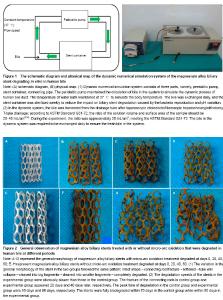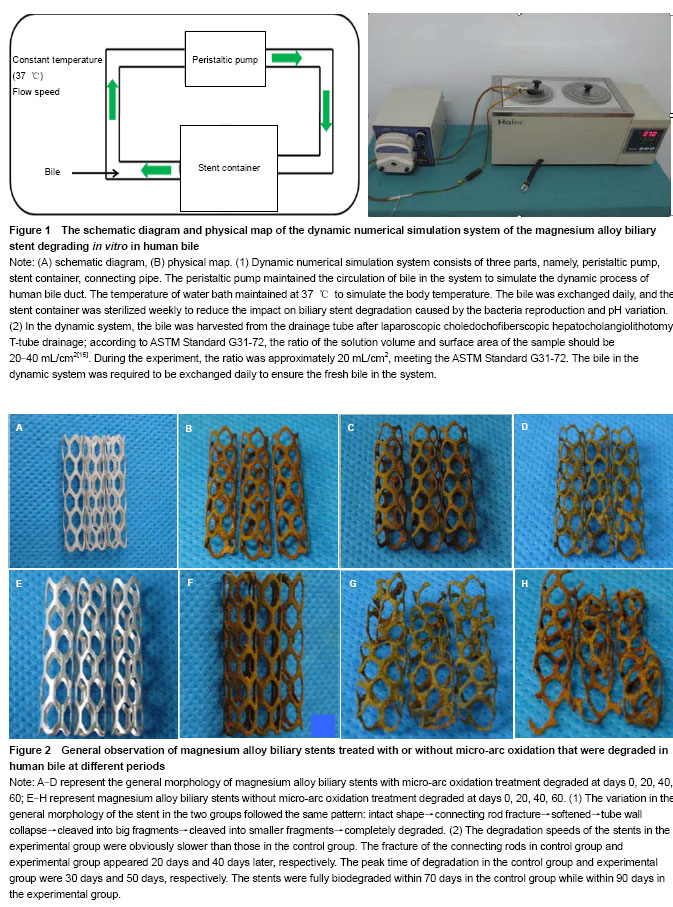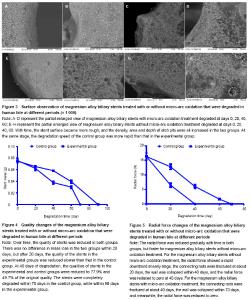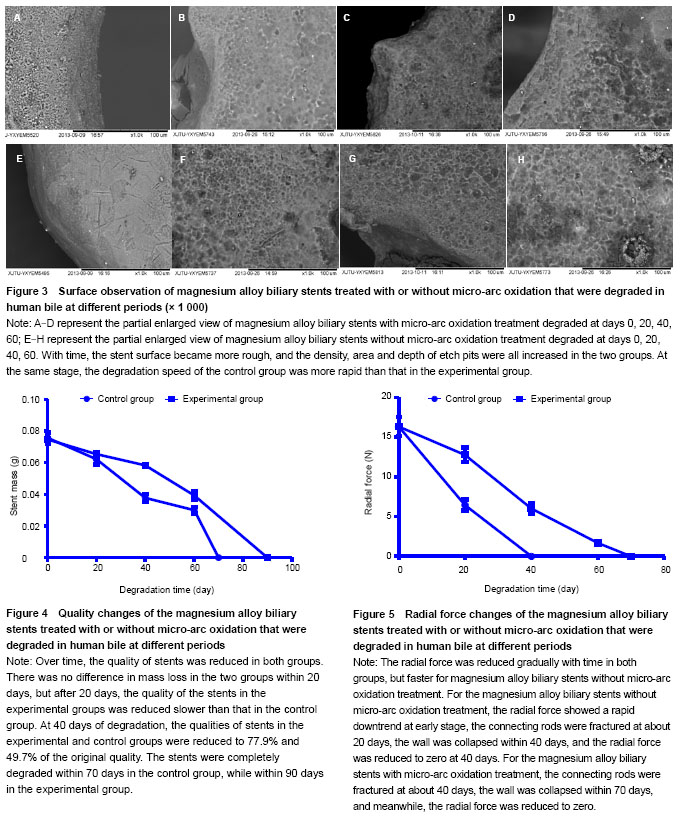Chinese Journal of Tissue Engineering Research ›› 2014, Vol. 18 ›› Issue (25): 3980-3986.
Previous Articles Next Articles
In vitro biodegradation and mechanical characteristics of a novel biliary stent made of magnesium alloy
Wang Jin-rui, Yu Liang, Shi Jian-hua, Wang Bo, Lv Yi, Hao Jie
- Department of Hepatobiliary Surgery, the First Affiliated Hospital, Xi’an Jiaotong University, Xi’an 710061, Shaanxi Province, China
-
Received:2014-04-11Online:2014-06-18Published:2014-06-18 -
Contact:Yu Liang, M.D., Professor, Master’s supervisor, Department of Hepatobiliary Surgery, the First Affiliated Hospital, Xi’an Jiaotong University, Xi’an 710061, Shaanxi Province, China -
About author:Wang Jin-rui, Studying for master’s degree, Department of Hepatobiliary Surgery, the First Affiliated Hospital, Xi’an Jiaotong University, Xi’an 710061, Shaanxi Province, China -
Supported by:Shaanxi Provincial Science and Technology Innovation Project, No. 2011KTCL03-21
CLC Number:
Cite this article
Wang Jin-rui, Yu Liang, Shi Jian-hua, Wang Bo, Lv Yi, Hao Jie. In vitro biodegradation and mechanical characteristics of a novel biliary stent made of magnesium alloy[J]. Chinese Journal of Tissue Engineering Research, 2014, 18(25): 3980-3986.
share this article
Add to citation manager EndNote|Reference Manager|ProCite|BibTeX|RefWorks

Morphological changes of the stents in the two groups(1) The variation in the general morphology of the stent in the two groups followed the same pattern: intact shape→ connecting rod fracture→softened→tube wall collapse→cleaved into big fragments→cleaved into smaller fragments→completely degraded. (2) The degradation speeds of the stents in the experimental group were obviously slower than those in the control group. The fracture of the connecting rods in control group and experimental group appeared 20 days and 40 days later, respectively. The peak time of degradation in the control group and experimental group were 30 days and 50 days, respectively. The stents were fully biodegraded within 70 days in the control group while within 90 days in the experimental group (Figure 2). (3) Scanning electron microscope observation: after drying, the stent was amplified locally by the scanning electron microscope to understand the changes in the stent structure. Although the sediments and corrosion products on the stent surface had been removed, there was still a small amount of impurities on the specimen surface. The roughness, etch pit density, area and depth on the stent surface reflected the degree of stent degradation. With time, the stent surface became more rough, and the density, area and depth of etch pits were all increased in the two groups. At the same stage, the degradation speed of the control group was more rapid than that in the experimental group"

| [1] Hänzi AC, Gerber I, Schinhammer M, et al. On the in vitro and in vivo degradation performance and biological response of new biodegradable Mg–Y–Zn alloys. Acta Biomaterialia. 2010;6(5):1824-1833. [2] Lu P, Fan H, Liu Y, et al. Controllable biodegradability, drug release behavior and hemocompatibility of PTX-eluting magnesium stents. Colloids Surfaces B Biointerfaces. 2011; 83(1):23-28. [3] Jamesh M, Kumar S, Sankara Narayanan TSN. Corrosion behavior of commercially pure Mg and ZM21 Mg alloy in Ringer's solution – Long term evaluation by EIS. Corros Sci. 2011;53(2):645-654. [4] Ng WF, Chiu KY, Cheng FT. Effect of pH on the in vitro corrosion rate of magnesium degradable implant material. Mater Sci Eng. 2010;30:898-903. [5] Gu X, Zheng Y, Cheng Y, et al. In vitro corrosion and biocompatibility of binary magnesium alloys. Biomaterials. 2009;30(4):484-498. [6] Witte F, Ulrich H, Rudert M, et al. Biodegradable magnesium scaffolds: Part 1: Appropriate inflammatory response. J Biomed Mater Res. 2007;81A(3):748-756. [7] Witte F, Ulrich H, Palm C, et al. Biodegradable magnesium scaffolds: Part II: Peri-implant bone remodeling. J Biomed Mater Res. 2007;81A(3):757-765. [8] Waksman R, Pakala R, Kuchulakanti PK, et al. Safety and efficacy of bioabsorbable magnesium alloy stents in porcinecoronary arteries. Catheter Cardiovasc Inter. 2006;68(4):607-619. [9] Di Mario C, Griffiths H, Goktekin O, et al. Drug-eluting bioabsorbable magnesium stent. J Interv Cardiol. 2004; 17(6):391-395. [10] Zartner P, Cesnjevar R, Singer H, et al. First successfulimplantation of a biodegradable metal stent into the leftpulmonary artery of a preterm baby. Catheter Cardiovasc Interv. 2005;66(4):590-594. [11] Schranz D, Zartner P, Michel-Behnke I, et al. Bioabsorbable metal Stents for percutaneous treatment of critical recoarctation of the aorta in a newborn. Catheter Cardiovasc Interv. 2006;67(5):671-673. [12] McMahan CJ, Oslizlok P, Walsh KP. Early restenosis following biodegradable stent implantation in an aortopulmonary collateralof a patient with pulmonary atresia and hypoplastic pulmonary arteries. Catheter Cardiovasc Inter. 2007;69:735-738. [13] Peeters P, Bosiers M, Verbist J, et al. Preliminary results after application of absorbable metal stents in patients with critical limb ischemia. J Endovasc Ther. 2005;12(1):1-5. [14] Erbel R, Di Mario C, Bartunek J, et al. Temporary scaff olding of coronary arteries with bioabsorbable magnesium stents: A prospective, non-randomised multicentre trial. Lancet. 2007;369(9576):1869-1875. [15] Zhang J, Zong Y, Yuan GY, et al. Degradable behavior of new-type medical Mg-Nd-Zn-Zr magnesium alloy in simulated body fluid. Zhongguo Youse Jinshu Xuebao. 2010; 20(10):1989-1997. [16] Li HW, Xu K, Yang K, et al. The degradation performance of AZ31 bioabsorbable magnesium alloy stent implanted in the abdominal aorta of rabbits. Jieru Fangshexue Zazhi. 2010;19(4):315-317. [17] Majumdar JD, Bhattacharyya U, Biswas A, et al. Studies on thermal oxidation of Mg-alloy (AZ91)for improving corrosion and wear resistance. Surf Coat Techn. 2008;202(15): 3638-3642. [18] Xin YC, Liu L, Huo KF, et al. Corrosion behavior of ZrN/Zr coated biomedical AZ91 magnesium alloy. Surf Coat Techn. 2009;203(17-18):2554-2557. [19] Zhang S, Zhang X, Zhao C, et al. Research on an Mg-Zn alloy as a degradable biomaterial. Acta Biomater. 2010;6(2):626-640. [20] Yu L, Han B, Miao S, et al. Biodegradation and mechanical characteristics of poly(lactic-co-glycolic acid) biliary stents in vitro. Didi Junyi Daxue Xuebao. 2007;28(23):2138-2140. [21] Liu Q, Lei LP, Zeng Y, et al. Numreical and experimental study of radial support capacity of intravascular stent. Zhongguo Yiliao Qixie Zazhi. 2010;34(3):175-179. [22] Waksman R, Erbel R, Di Mario C, et al. Early- and long-term intravascular ultrasound and angiographic findings after bioabsorbable magnesium stent implantation in human coronary arteries. JACC Cardiovasc Interv. 2009; 2(4):312-320 [23] Ghimire G, Spiro J, Kharbanda R, et al. Initial evidence for the return of coronary vasoreactivity following the absorption of bioabsorbable magnesium alloy coronary stents. EuroIntervention. 2009;4(4):481-484. [24] Waksman R, Pakala R, Okabe T, et al. Efficacy and safety of absorbable metallic stents with adjunct intracoronary beta radiation in porcine coronary arteries. J Interv Cardiol. 2007;20(5):367-372. [25] Qiao LY, Gao JC, Wang Y. Corrosion degradation of surface modified bio-magnesium materials by heat-self-assembled monolayer. Cailiao Yanjiu Xuebao. 2009;23(2):153-157. [26] Gu XN, Zheng W, Cheng Y, et al. A study on alkaline heat treated Mg-Ca alloy for the control of the biocorrosion rate. Acta Biomater. 2009;5(7):2790-2799. |
| [1] | Wang Liang, Guo Yuxing, Wu Xun, Huang Hua, Yuan Guangyin, Zhang Lei. Antibacterial properties of Jiao Da Bio-Magnesium scaffolds in vitro [J]. Chinese Journal of Tissue Engineering Research, 2021, 25(16): 2506-2513. |
| [2] | Tang Mengmeng, Chen Hechun, Xie Hongchen, Zhang Yu, Tan Xiaoshuang, Sun Yixuan, Huang Yina. Histocompatibility of poly(L-lactide-co-ε-caprolactone)/cross-linked polyvinylpyrrolidone ureteral stent grafted into the rat bladder [J]. Chinese Journal of Tissue Engineering Research, 2020, 24(4): 583-588. |
| [3] | Zhang Yanan, Yan Xia, Meng Zengdong. Zn and Mg increase the bioactivity and osteogenic induction of hydroxyapatite biomaterial in bone repair: clinical application and mechanism [J]. Chinese Journal of Tissue Engineering Research, 2020, 24(4): 606-611. |
| [4] | Lei Senlin, Liu Hongyuan, Yang Hongsheng, Xiong Yan, Duan Hong. In vivo biosafety and histocompatibility of absorbable poly-D,L-lactic acid screws implanted with ultrasound-assisted technology [J]. Chinese Journal of Tissue Engineering Research, 2020, 24(34): 5454-5460. |
| [5] | Guo Enhui, Xu Zitong, Liang Yize, Zhou Liang, Lu Zhaoxiang, You Liang, Xia Yujun. Properties of a novel photocrosslinked fish collagen peptide-hyaluronic acid hydrogel [J]. Chinese Journal of Tissue Engineering Research, 2020, 24(28): 4518-4525. |
| [6] | Sun Xirao, Sun Baozhai, Zhang Zhenbao. Combination of magnesium ion with mineralized collagen intervenes osteogenic differentiation of mouse preosteoblasts [J]. Chinese Journal of Tissue Engineering Research, 2020, 24(22): 3467-3473. |
| [7] | Ma Rui, Wang Jialin, Li Yongwei, Wang Wei. In vitro antibacterial activity and biocompatibility of a porous scaffold containing magnesium [J]. Chinese Journal of Tissue Engineering Research, 2020, 24(22): 3534-3539. |
| [8] | Sun Xirao, Wang Chengyue, Zhao Yuan, Zhang Zhenbao. In vitro corrosion and in vivo biosafety of pure magnesium film [J]. Chinese Journal of Tissue Engineering Research, 2020, 24(16): 2578-2584. |
| [9] | Cheng Lei, Jin Jian, Hu Jingguo, Lu Yusong. Inflammatory reaction and lactic acid concentration after implantation of polylactic acid rib nail versus pure titanium embracing fixator in animals#br# [J]. Chinese Journal of Tissue Engineering Research, 2020, 24(16): 2567-2571. |
| [10] | Wang Yang, Song Zhuoyue, Li Guangheng. Synergistic promotion of inflammatory chondrocyte reverse differentiation by the combination of curcumin and magnesium sulfate [J]. Chinese Journal of Tissue Engineering Research, 2019, 23(9): 1410-1415. |
| [11] | Yuan Bo, Wang Zhiwei, Tang Yifan, Zhou Shengyuan, Chen Xiongsheng, Jia Lianshun. Construction of polycaprolactone-tricalcium phosphate with different mixture ratios using three-dimensional printing technology and its osteoinductivity in vitro [J]. Chinese Journal of Tissue Engineering Research, 2019, 23(6): 821-826. |
| [12] | Tian Hongju, Chen Zhongqing. Poly(lactid-co-glycolide) nanoparticles loaded with ropivacaine: preparation and in vivo release in animals [J]. Chinese Journal of Tissue Engineering Research, 2019, 23(6): 924-929. |
| [13] | Wu Bo, Li Xiangkui, Wang Hua, Wen Zhiyuan. Sustained-release properties and histocompatibility of ropivacaine-coated polyethylene glycol/polylactic acid microspheres implanted around the sciatic nerve [J]. Chinese Journal of Tissue Engineering Research, 2019, 23(34): 5486-5491. |
| [14] | Wang Liang, Guo Yuxing, Huang Hua, Yuan Guangyin, Zhang Lei. Evaluation of biosafety of porous magnesium alloy scaffolds for jaw defects [J]. Chinese Journal of Tissue Engineering Research, 2019, 23(26): 4121-4128. |
| [15] | Li Li, Wang Xinling, Liu Suxin, Huo Yan. Effects of magnesium on proliferation, adhesion and apoptosis of endothelial progenitor cells in patients with preeclampsia [J]. Chinese Journal of Tissue Engineering Research, 2019, 23(21): 3371-3377. |
| Viewed | ||||||
|
Full text |
|
|||||
|
Abstract |
|
|||||

